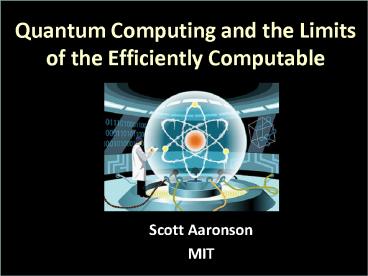Quantum Computing and the Limits of the Efficiently Computable - PowerPoint PPT Presentation
1 / 20
Title:
Quantum Computing and the Limits of the Efficiently Computable
Description:
Quantum Computing and the Limits of the Efficiently Computable Scott Aaronson MIT * * But while we re waiting for scalable quantum computers, we can also base ... – PowerPoint PPT presentation
Number of Views:64
Avg rating:3.0/5.0
Title: Quantum Computing and the Limits of the Efficiently Computable
1
Quantum Computing and the Limits of the
Efficiently Computable
- Scott Aaronson
- MIT
2
Things we never see
Warp drive
Übercomputer
Perpetuum mobile
The (seeming) impossibility of the first two
machines reflects fundamental principles of
physicsSpecial Relativity and the Second Law
respectively So what about the third one?
3
NP-hard
NP-complete
NP
P
4
Does PNP?
The (literally) 1,000,000 question
If there actually were a machine with running
time Kn (or even only with Kn2), this would
have consequences of the greatest
magnitude.Gödel to von Neumann, 1956
5
Extended Church-Turing Thesis
An important presupposition underlying P vs. NP
is the...
Any physically-realistic computing device can be
simulated by a deterministic or probabilistic
Turing machine, with at most polynomial overhead
in time and memory
So how sure are we of this thesis? Have there
been serious challenges to it?
6
Old proposal Dip two glass plates with pegs
between them into soapy water. Let the soap
bubbles form a minimum Steiner tree connecting
the pegsthereby solving a known NP-hard problem
instantaneously
7
Other Approaches
Protein folding Can also get stuck at local
optima (e.g., Mad Cow Disease) DNA computers
Just massively parallel classical computers
8
Ah, but what about quantum computing?
Quantum mechanics Probability theory with minus
signs (Nature seems to prefer it that way)
In the 1980s, Feynman, Deutsch, and others
noticed that quantum systems with n particles
seemed to take 2n time to simulateand had the
amazing idea of building a quantum computer to
overcome that problem
Actually building a QC Damn hard, because of
decoherence. (But seems possible in principle!)
9
Science Popularizers BewareA quantum computer
is NOT a massively-parallel classical computer!
Exponentially-many basis states, but you only get
to observe one of them
Any hope for a speedup rides on the magic of
quantum interference
10
BQP (Bounded-Error Quantum Polynomial-Time) The
class of problems solvable efficiently by a
quantum computer, defined by Bernstein and
Vazirani in 1993
Shor 1994 Factoring integers is in BQP
11
Remember factoring isnt thought to be
NP-complete! Today, we dont believe BQP contains
all of NP (though not surprisingly, we cant
prove that it doesnt)
Bennett et al. 1997 Quantum magic wont be
enough
If you throw away the problem structure, and just
consider an abstract landscape of 2n possible
solutions, then even a quantum computer needs
2n/2 steps to find the correct one (That bound
is actually achievable, using Grovers algorithm!)
So, is there any quantum algorithm for
NP-complete problems that would exploit their
structure?
12
Quantum Adiabatic Algorithm(Farhi et al. 2000)
Hi
Hf
Hamiltonian with easily-prepared ground state
Ground state encodes solution to NP-complete
problem
Problem Eigenvalue gap can be exponentially
small
13
Nonlinear variants of the Schrödinger Equation
Abrams Lloyd 1998 If quantum mechanics were
nonlinear, one could exploit that to solve
NP-complete problems in polynomial time
1 solution to NP-complete problem
No solutions
14
Relativity Computer
DONE
15
Zenos Computer
Time (seconds)
16
Closed Timelike Curves (CTCs)
Heres a polynomial-time algorithm to solve
NP-complete problems (only drawback is that it
requires time travel) Read an integer
x?0,,2n-1 from the future If x encodes a
valid solution, then output x Otherwise, output
(x1) mod 2n
If valid solutions exist, then the only
fixed-points of the above program input and
output them
Building on work of Deutsch, A.-Watrous 2008
defined a formal model of CTC computation, and
showed that in both the classical and quantum
cases, it has exactly the power of PSPACE
(believed to be even larger than NP)
17
Includes P?NP as a special case, but is
stronger No longer a purely mathematical
conjecture, but also a claim about the laws of
physics If true, would explain why adiabatic
systems have small spectral gaps, the Schrödinger
equation is linear, CTCs dont exist...
18
Question What exactly does it mean to solve an
NP-complete problem?
Example Its been known for decades that, if you
send n identical photons through a network of
beamsplitters, the amplitude for the photons to
reach some final state is given by the permanent
of an n?n matrix of complex numbers
Lesson If you cant observe the answer, it
doesnt count! Recently, Alex Arkhipov and I gave
the first evidence that even the observed output
distribution of such a linear-optical network
would be hard to simulate on a classical
computerbut the argument was necessarily more
subtle
But the permanent is P-complete (believed even
harder than NP-complete)! So how can Nature do
such a thing?
Resolution The amplitudes arent directly
observable, and require exponentially-many
probabilistic trials to estimate
19
Conclusion
One could imagine worse research agendas than the
following Prove P?NP (better yet, prove
factoring is classically hard, implying
P?BQP) Prove NP?BQPi.e., that not even quantum
computers can solve NP-complete problems Build a
scalable quantum computer (or even more
interesting, show that its impossible) Determine
whether all of physics can be simulated by a
quantum computer Derive as much physics as one
can from No-SuperSearch and other impossibility
principles
20
Papers, talk slides, blog www.scottaaronson.com































